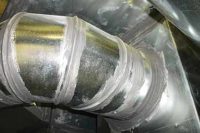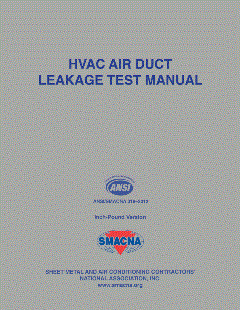A subject that is sure to get some hearty debate going is whether ducts inside a conditioned space should be sealed or not. What is your opinion on this sticking point of energy efficiency?
No Sealing Needed

|
| Can you really be sure airflow is making it to the proper areas if a duct system is unsealed? |
On one side of this debate, you have those who adamantly proclaim that sealing a duct system located inside the conditioned space has little impact on energy savings since any leakage is inside the conditioned space. After all, any air leakage is still within the conditioned space and technically not being lost to the outside.
Many are going to take this side of the debate, as the energy code doesn’t mandate duct leakage testing on systems that have all ducts located within the conditioned space. If code doesn’t mandate duct leakage testing on ducts within a conditioned space, it must not be a big deal, right?
Seal the Ducts
On the other side of this debate, you have those who are just as passionate, claiming every duct system needs to be sealed as close to 100 percent airtight as possible, regardless of the duct location. After all, if the air is being lost through duct leakage to a space it isn’t supposed to be going, how can you ensure proper airflow delivery to every room?
Both sides of the debate bring up some great points, but who is right? Let’s examine the facts, and then you can decide whether a duct system inside the conditioned space should be sealed or not.
Basic Rules of Airflow
Although airflow is often invisible and can’t be physically handled, it follows some very basic rules that allow us to predict its properties and characteristics. By examining a few of these basic rules, we can begin to determine if ducts in a conditioned space really do need to be sealed, or if leaving them unsealed is perfectly acceptable.
Rule No. 1: Air will always follow the path of least resistance. Air is pretty lazy when it comes to how it moves around inside a duct system. When a nice large opening close to the equipment is available, air will gladly go through that opening instead of bypassing it to head to the appropriate supply register. This rule may sound simple, but it’s often forgotten and its impact minimized.
Rule No. 2: One cfm of airflow into a fan equals 1 cfm of airflow out of the fan. Airflow is measured in cfm or cubic feet per minute. For every 1 cfm that is pulled into the blower wheel of the fan in the air-handling equipment, there is 1 cfm coming out of the blower wheel.
Let’s say you have a 3-ton system that’s operating in cooling mode. You measure the actual fan airflow at the air-handling equipment and determine you are moving 1,210 cfm through the fan. This means you have 1,210 cfm of air being pulled into the blower wheel of the fan and 1,210 cfm of air being discharged from the fan. This doesn’t mean you have 2,420 cfm of total airflow though; you’re only working with 1,210 cfm. The fan is only moving that amount of airflow from the inlet of the fan to the outlet of the fan. The fan doesn’t create additional airflow.
Rule No. 3: Airflow is always highest at the fan, just as static pressure will always be highest at the fan. As air moves down the duct system and farther away from the fan, airflow begins to decrease as it is delivered through individual branch runs to rooms of a building.
Now, let’s apply these fundamental aspects of airflow to determine if ducts in conditioned space should be sealed.
Duct Leakage Impacts
A complaint that many of us have received is that a certain room at the farthest end of a home isn’t getting comfortable. During the winter, this room is just too cold, and in the summer, this room is too hot. Sound familiar?
There is a good possibility we can apply a couple of basic airflow rules here to determine what is going on in this scenario. Since air takes the path of least resistance (rule No. 1), it’s much easier for it to pass through an unintended leak in the duct system than to travel all the way through the duct system, to a problem room at the farthest end of a home.
In the previous example I gave of the 3-ton system moving 1,210 cfm of air, for that system to function as designed, it’s important to get as close to 100 percent of that 1,210 cfm from the fan in the equipment to the intended points of delivery (individual rooms).
There is only so much fan airflow to deal with from the air-handling equipment. If it’s being lost through duct leakage, you’ll never be able to have true control over the air in the duct system.
To control air, you first have to contain it. This becomes a very painful truth to anyone who has attempted to air balance a duct system that has not been sealed.
You just can’t air balance a leaky duct system. This is true regardless of the duct system location. Because our industry has a tendency to assume performance instead of measuring it, this fact often gets overlooked and is instead assumed.
When a duct system hasn’t been sealed, you have no way of controlling where the air in the ducts will go. If conditions exist in a duct system that allows air to bypass its intended delivery point, it will take the path of least resistance all day long. Airflow is one of the key components of the Btu formulas. In order to have proper Btu delivery to individual rooms, the first item that has to be considered is whether the proper amount of airflow is being delivered into the building.
You might be wondering how this could affect energy efficiency. Uncomfortable occupants typically adjust the thermostat to become comfortable in those farthest rooms. By adjusting the thermostat, the equipment now runs longer in an attempt to achieve comfort.
This adjustment of the thermostat directly affects energy efficiency, as Btu delivery isn’t being achieved where it’s needed. Even with the Btu being lost into a conditioned space, the occupants don’t directly benefit from that loss in relationship to their comfort. They don’t feel the Btu lost to a basement from that farthest room.
Pressure imbalances are another issue created by duct leakage that can occur with ducts in a conditioned space. Unless air is contained and controlled in a duct system, it can change the pressures in a home drastically, even if all ducts are inside the home.
The safety impacts associated with this are often forgotten, as imbalanced pressures can cause combustion appliances in a home to spill flue gases into the living area. Depressurization in homes with attached garages can lead to carbon monoxide from auto exhaust being pulled into the home for occupants to breathe.
Is your position on this debate the same, or has it changed any? Ultimately, the real answers to this debate are found through performance testing of the systems you install. Unless you’re testing your systems, you’ll never see these types of interactions. This isn’t about whether the ducts in a particular location need to be tested for leakage or not based on energy code manadates. It’s about doing the right thing for your customers and verifying your systems truly do what you promised they would.
Publication date: 4/13/2015
Want more HVAC industry news and information? Join The NEWS on Facebook, Twitter, and LinkedIn today!











